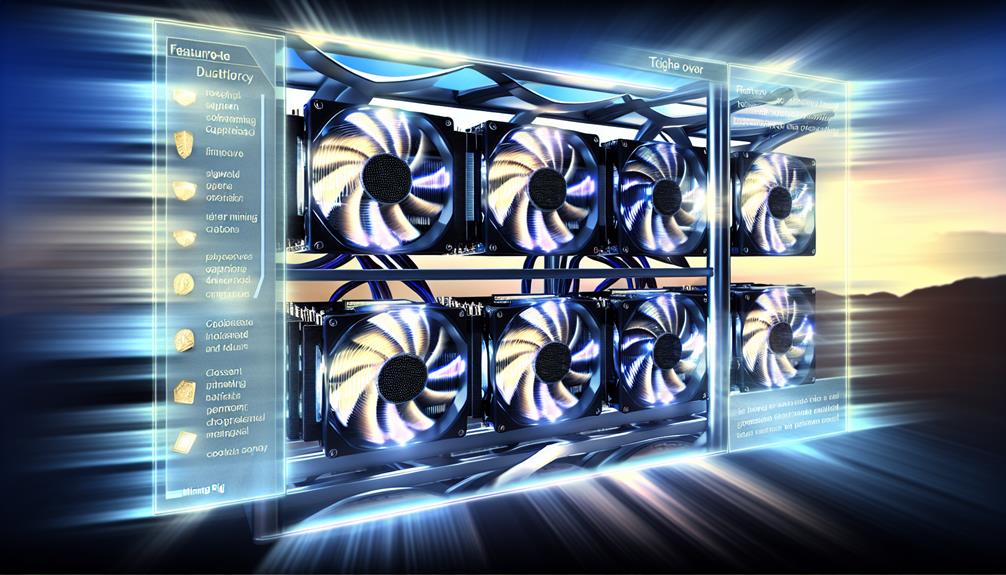If you're considering farming Bitcoin in 2024, you might be wondering how long it'll actually take to see results. The answer isn't straightforward, as several factors come into play, including mining difficulty and the efficiency of your hardware. You'll also need to think about electricity costs and your location, which can greatly affect your operation's profitability. As you weigh your options, the evolving market landscape and upcoming reward halving events could shift your perspective on what it means to farm Bitcoin. What strategies will you need to adapt as conditions change?
Understanding Bitcoin Mining Basics

Bitcoin mining is the backbone of the Bitcoin network, serving both as a method for transaction validation and a means of introducing new coins into circulation. When you participate in mining, you're fundamentally competing against others to solve complex cryptographic problems, a process that's directly influenced by mining difficulty. This difficulty adjusts approximately every two weeks, ensuring that the average time to mine a block remains around ten minutes, regardless of the total computing power of the network.
One vital aspect you need to take into account is energy consumption. Mining requires substantial computational power, leading to significant electricity usage. As a miner, you'll need to balance the cost of energy against potential earnings from mined Bitcoin and transaction fees. Transaction fees can vary based on network demand, impacting your profitability.
Many miners opt to join mining pools, which allow them to combine resources and share rewards based on their contributed processing power. This collective approach increases the likelihood of successfully mining a block, resulting in more stable earnings compared to solo mining.
Understanding these fundamentals can help you navigate the complexities of Bitcoin mining more effectively. You'll be better prepared to make informed decisions, whether you're contemplating investing in mining hardware or evaluating the potential returns based on current market conditions. By grasping how mining difficulty, energy consumption, transaction fees, and mining pools interact, you'll position yourself to optimize your mining strategy.
Factors Affecting Mining Time
When considering how long it takes to mine Bitcoin, several factors come into play that can significantly influence your overall mining time. One significant factor is mining difficulty, which adjusts approximately every two weeks based on the network hash rate. As more miners join the network, mining difficulty increases, making it harder and longer to solve blocks.
Electricity costs are another vital variable. High electricity prices can eat into your profits, potentially leading you to reconsider your mining strategy. If you're part of a mining pool, you might find that pooling resources can reduce the time it takes to mine Bitcoin collectively, though rewards are shared among participants.
Your geographic location matters too. Regions with lower electricity rates, cooler climates, and favorable regulations can enhance your mining efficiency. Cooling solutions are essential for maintaining ideal equipment performance, as overheating can lead to reduced equipment lifespan and downtime, ultimately affecting your mining time.
Reward halving is a significant event that occurs roughly every four years, reducing the Bitcoin reward for mining by half. This event impacts profitability and can indirectly affect how long it takes to mine Bitcoin, as miners adjust their strategies in response to changing rewards.
Lastly, the lifespan of your mining equipment also plays a role. Older machines may become obsolete as the network evolves, leading to longer mining times as they struggle to compete with newer, more efficient models. All these factors combined create a complex landscape that influences your mining journey.
Hardware Options for 2024

As mining difficulty continues to evolve, choosing the right hardware becomes increasingly important for those looking to enter or upgrade their mining operations in 2024. You'll primarily have two options: ASIC miners and GPU rigs. ASIC miners are designed specifically for Bitcoin mining and generally offer superior hashing power and energy efficiency. However, their upfront cost can be significant, and you may face longevity concerns due to rapid technological advancements.
On the other hand, GPU rigs provide more versatility, allowing you to mine various cryptocurrencies. While they may not match the efficiency of ASIC miners for Bitcoin, they can be more adaptable for future mining opportunities. If you're considering a GPU setup, pay attention to the cooling solutions, as efficient thermal management is vital for maintaining performance and prolonging hardware life.
Joining mining pools can also enhance your chances of profitability, particularly if you opt for GPUs. Pools enable you to combine resources with other miners, increasing the likelihood of earning rewards, albeit with shared payouts.
When upgrading your hardware, consider noise levels, especially if you're mining in a residential area. ASIC miners tend to be noisier, which might be a concern for some. For both ASIC and GPU setups, prioritizing energy efficiency is essential to minimize operating costs. In conclusion, weigh the pros and cons of each hardware option, assess your budget, and think about your long-term mining strategy to make an informed decision in 2024.
Calculating Profitability and ROI
Understanding profitability and calculating your return on investment (ROI) are vital steps for anyone serious about mining in 2024. To determine your profitability, you'll need to analyze several factors, including the mining algorithms you plan to use, energy costs, and the current price of Bitcoin.
First, evaluate the mining algorithms. Different algorithms have varying levels of efficiency, which directly impact how much Bitcoin you can mine. For instance, some algorithms may require more computational power, increasing your energy costs. It's essential to choose an algorithm that aligns with your hardware capabilities and energy consumption.
Next, consider energy costs, which are often the largest expense in mining operations. The price of electricity can vary greatly depending on your location. To calculate ROI, you'll need to factor in these energy costs against your expected earnings from mining Bitcoin. Create a detailed spreadsheet that includes your hardware costs, ongoing energy expenses, and the potential earnings based on current mining difficulty and Bitcoin price.
Current Market Trends and Impacts

Fluctuations in the Bitcoin market considerably impact mining operations, influencing both profitability and the overall strategy miners must adopt. With increasing market volatility, the profitability of mining can shift dramatically, requiring miners to remain agile and responsive to both price changes and mining difficulty adjustments.
The recent focus on regulatory changes also plays a significant role. Governments worldwide are scrutinizing Bitcoin mining's environmental impact, as energy consumption remains a significant concern. In response, many miners are exploring greener technologies and alternative energy sources to mitigate their carbon footprints.
To further illustrate these trends, here's a snapshot of key factors affecting mining strategies:
| Factor | Impact on Mining |
|---|---|
| Market Volatility | Affects profitability and ROI |
| Mining Difficulty | Adjusts regularly, impacting solo vs. pool mining |
| Regulatory Changes | Influence operational costs and methods |
Technological advancements are another vital component. Innovations in mining hardware can lead to increased efficiency, allowing miners to adapt to rising difficulty levels. Consequently, the choice between pool mining and solo mining becomes a strategic decision influenced by both current market conditions and future projections.
Frequently Asked Questions
Can I Mine Bitcoin on a Laptop in 2024?
You can mine Bitcoin on a laptop, but its specifications will greatly impact mining profitability. Most laptops lack the necessary power and efficiency, making it unlikely you'll earn significant returns compared to dedicated mining rigs.
What Is the Environmental Impact of Bitcoin Mining?
Bitcoin mining's environmental impact largely depends on energy sources. If you're using sustainable mining practices, like renewable energy, it can mitigate negative effects. However, reliance on fossil fuels contributes considerably to carbon emissions and climate change.
How Do Mining Pools Work for Beginners?
Mining pools combine resources from multiple miners, increasing chances of earning mining rewards. Participants share rewards based on their contribution after deducting pool fees. This collaborative approach enhances efficiency and profitability, especially for beginners traversing the mining landscape.
Are There Any Legal Restrictions on Bitcoin Mining?
Bitcoin's booming business can bring burdensome barriers. You'll need to navigate legal regulations and secure mining permits, as many jurisdictions impose restrictions that could impact your operations. Always check local laws before diving into mining.
What Happens to My Earnings if the Network Becomes Congested?
If the network experiences congestion, your earnings might be impacted. Higher transaction fees can arise, causing delays in processing your transactions. This could affect the speed and overall profitability of your mining efforts.
Conclusion
In 2024, farming Bitcoin isn't just a race; it's a chess game where every move counts. With factors like mining difficulty, hardware choices, and market trends playing significant roles, your strategy must adapt to the shifting landscape. By understanding these variables and calculating your potential ROI, you can navigate the complexities of Bitcoin mining more effectively. Ultimately, staying informed and agile will be key to maximizing your efforts and achieving success in this ever-evolving environment.
